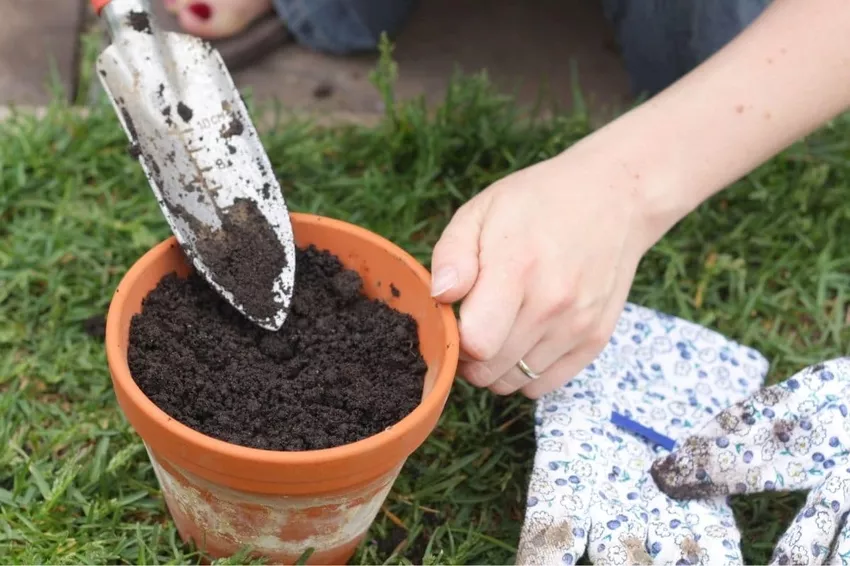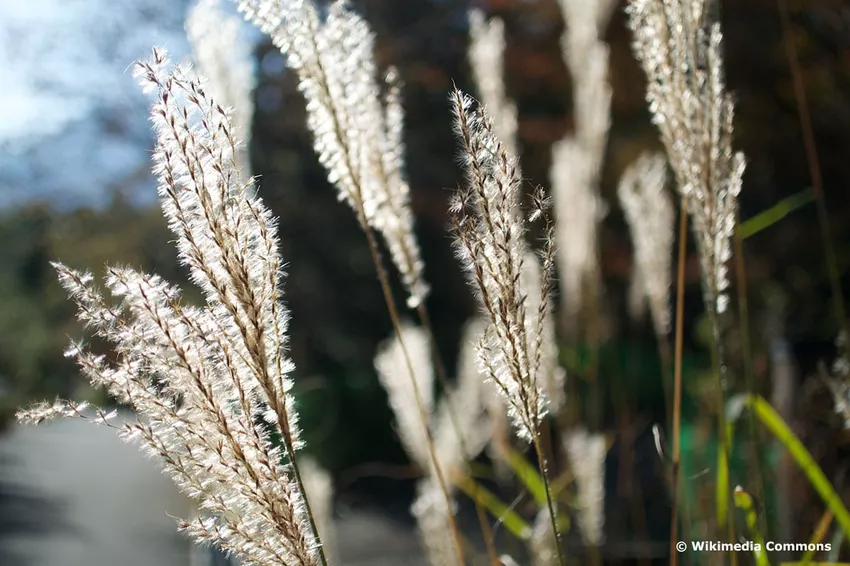
Chinese reed (Miscanthus sinensis) can be excellently cultivated in a bucket. If you also want to keep the popular ornamental grasses in the pot, you have to pay attention to certain points when caring for them.
In a nutshell
- prefers a moist substrate
- sunny locations are ideal
- regular watering important
- annual trimming required
- Propagation by division possible
substrate
In order to make cultivation in the tub as pleasant as possible for the Micanthus species, the substrate must be right. These are undemanding plants that, above all, need good drainage as they love moisture. However, they do not tolerate waterlogging. You should consider the following points with the substrate:
- select high quality substrates
- Potting soil, container plant substrate or garden soil are suitable
- Enrich garden soil with compost
- loosen up with quartz sand

Tip: Sterilize the garden soil before use. In this way you kill possible eggs and young of pests, as well as mold spores and pathogens.
repot
Chinese reed in tubs and flower boxes is very keen on growing and spreading, which makes it necessary to repot the plant every year. Repotting has a positive effect on the growth of the plant and protects against a lack of nutrients. The process is also important if you have bought a new copy. You should repot it immediately after purchase, as the pots used are simply too small. If you need to repot your already established specimens, an appointment in early April is recommended. The plant then has enough time to sprout again. The following guide will guide you through the necessary steps when repotting:
- Use buckets with drainage holes
- new tub two to three times as big
- Create a drainage layer in the new pot
- Drainage material: potsherds, expanded clay, gravel
- fill with substrate
- Remove plant from old container
- wear gloves
- Chinese reed stalks are sharp
- check roots
- remove rotten, dead or dried roots
- Soak the roots in water for a few minutes
- then put the plant in a new pot
- must sit 8 to 10 cm deep in the substrate
- fill with substrate
- press carefully
- water thoroughly

location
After you have put the plant in the new pot or repotted your previous specimens, you still need the right location. The Chinese reed is a plant that is ideal for balconies, terraces and courtyards due to its size and requirements. With the exception of conservatories, indoor spaces are only suitable to a limited extent, as they get too warm and dry, especially in winter. You should consider the following properties when you are looking for a place for the ornamental grasses:
- Light requirements: sunny to semi-shady
- Sun is preferred
- Shade will not be tolerated
- sheltered from the wind
pour
Micanthus species are grasses that need a moist substrate. For this reason, it is important to water them regularly, as the plants quickly suffer from drought damage. Especially when kept in tubs, drought stress quickly occurs, since there is less substrate than with cultivation outdoors. You also have to make sure that young specimens never dry out, otherwise they will shrink much faster. Proceed as follows when pouring:
- Water spring through fall
- use soft water
- Always keep the soil slightly moist
- check for moisture daily
- Do not let the top layer dry
- Definitely water every day during hot periods
- either in the morning or evening
- never past lunchtime
- too much irrigation water evaporates due to high solar radiation
- never water the plant directly
- only the substrate

Notice: You can cover your specimens with a mulch layer of brushwood so that the irrigation water administered does not immediately evaporate again in dry periods.
Fertilize
If you keep Chinese reed as a container plant, you have to reckon with a higher nutrient consumption than outdoors. The grasses are very hungry and must be supplied with sufficient nutrients accordingly. The advantage: If you repot every year, you can do without additional fertilizer because the plant has all the nutrients it needs until next year thanks to the fresh substrate. If you have missed changing the substrate, you will have to fertilize additionally over the vegetation period from late spring to autumn. This works as follows:
- fertilize every 4 weeks
- use organic garden or bamboo fertilizers
- administer over the irrigation water
- Dose according to the manufacturer's instructions
To cut
The cut is one of the most important care measures, so that the reeds do not grow too much and the new shoots are encouraged. Straws from last year have a negative effect on budding. For this reason, you should cut the Chinese reed in the spring, ideally before repotting it in a new bucket. The early cut also reduces the risk of cuts from the stalks when repotting. In addition to gloves, you will need pruning shears with sufficient leverage for the cut. Since the stalks of Miscanthus species are very robust, weaker pruning shears are not enough. The reed is cut back as follows:
- put on gloves
- Sharpen and disinfect secateurs
- join several stalks together in bundles
- Cut bundles back to 5 cm
- repeat for entire plant
- Dispose of straws on the compost or in organic waste
 Source: Photo by David J. Stang, Miscanthus sinensis Variegatus 3zz, edited by Plantopedia, CC BY-SA 4.0
Source: Photo by David J. Stang, Miscanthus sinensis Variegatus 3zz, edited by Plantopedia, CC BY-SA 4.0
Be sure to wash off areas of skin that have come into contact with the plant sap of the Chinese reed. It is phototoxic, which makes the skin more sensitive to UV radiation, leading to an increased risk of sunburn, blistering and itching.
hibernate
A big advantage of the Chinese reed in the bucket is the winter hardiness. The grasses can easily be kept on the balcony, terrace or in the conservatory over the winter without the vitality of the ornamental grass suffering as a result. You can even leave the individual specimens in their original location, as long as they are not too dark or permanently exposed to meltwater. As protection from the weather, you can place the ornamental grass in the doorway or under a roof. Despite the winter hardiness, you have to prepare the specimens cultivated in the pot for the cold season:
- When: mid-October to mid-November
- put on gloves
- Tie straws together
- use strong twine, sisal or hemp
- tie together in the top and middle third
- then pack the bucket
- Use garden fleece or brushwood mats
- Place bucket on styrofoam
- water moderately at regular intervals
- Fertilizer additions are not necessary
- unpack in early spring
- ideal just before repotting
 Young specimens tolerate a warming layer of twigs or dry foliage a few centimeters high.
Young specimens tolerate a warming layer of twigs or dry foliage a few centimeters high.
Tip: The material protects against drying out and possible frost damage, because young Chinese reed is not yet as robust as adult plants.
propagation
If you want to propagate your Miscanthus plants, the best way is to divide the root ball. In this way you can easily distribute even larger specimens to smaller pots and at the same time increase the amount of grasses. The ideal time to divide is in early spring when you are cutting and repotting the reeds. Since you remove the plant from the old tub when repotting, you have immediate access to the individual rhizomes and can use them for propagation. The following instructions explain the division step by step:
- put on gloves
- use sharp knife
- be sure to disinfect beforehand
- Cut reed beforehand
- Then remove the plant from the pot
- remove damaged, dead or rotten root
- select rhizomes
- cut off with the knife
- Plant rhizomes in new tubs
- Use substrate as when repotting
- water sufficiently
- put in a suitable location
- maintain as usual
 Source: Koichi Oda, Miscanthus sinensis - Flickr - odako1 (1), edited by Plantopedia, CC BY-SA 2.0
Source: Koichi Oda, Miscanthus sinensis - Flickr - odako1 (1), edited by Plantopedia, CC BY-SA 2.0
Propagation via seeds is possible all year round at temperatures of 20°C to 25°C and a germination period of 14 to 21 days. However, since the seedlings take a long time to reach the desired height, division is preferred for propagation.
frequently asked Questions
Is Chinese reed in the bucket susceptible to diseases or pests?Miscanthus species are extremely resistant to diseases and pests. The only problems are care errors, which often show up as discolored culms or poor vitality. Usually it is too much or too little water or there are not enough nutrients available. A wrong location also has a negative effect on the health of the plant.
Are the reeds dangerous for cats?Because of the long stalks, Chinese reed is interesting for cats, as they like to nibble on grass. The ornamental grass is not poisonous, but you should not let your house cat chew on the leaves. Since they are very sharp, your cat could injure itself. Painful cuts can occur, especially in the mouth.
Which types are suitable as privacy screens?The giant Chinese reed (Miscanthus giganteus) is particularly suitable for large balconies or terraces. It reaches heights of growth of up to 400 centimeters and can be grown in large pots just as easily. Be aware that it grows five to ten centimeters per day and therefore needs to be kept under control.